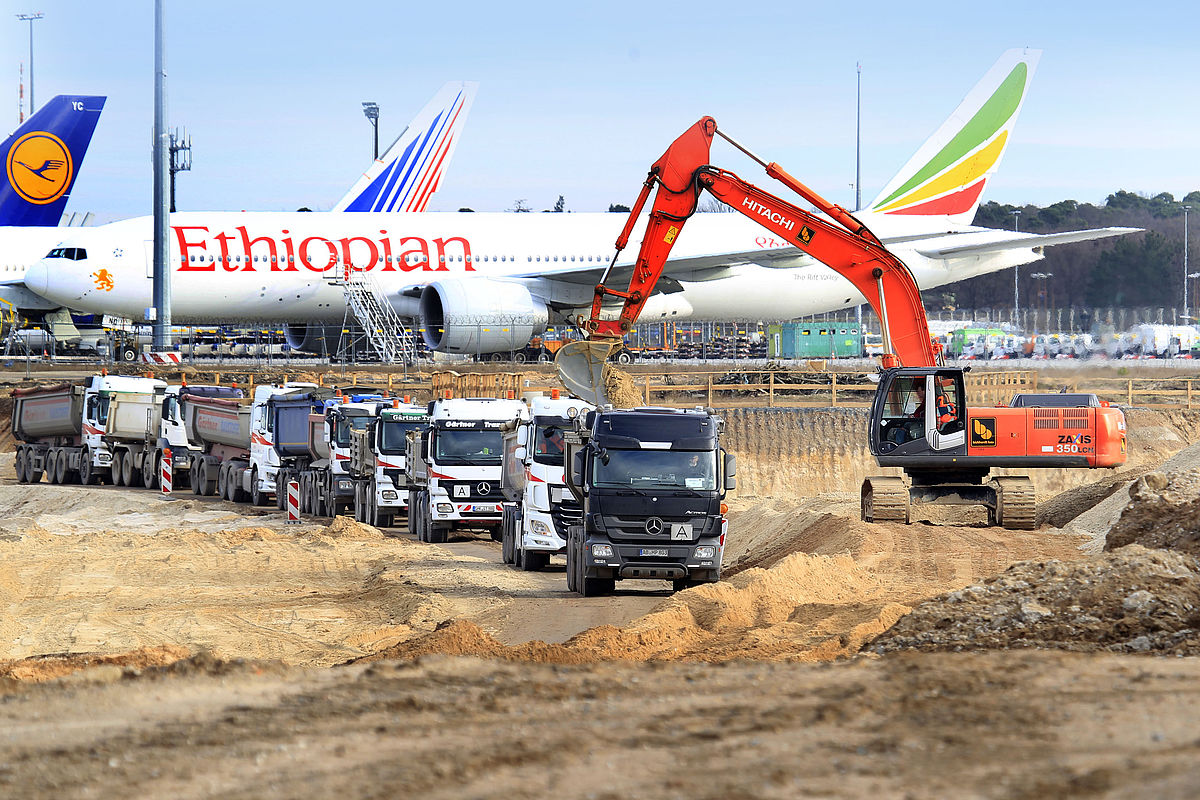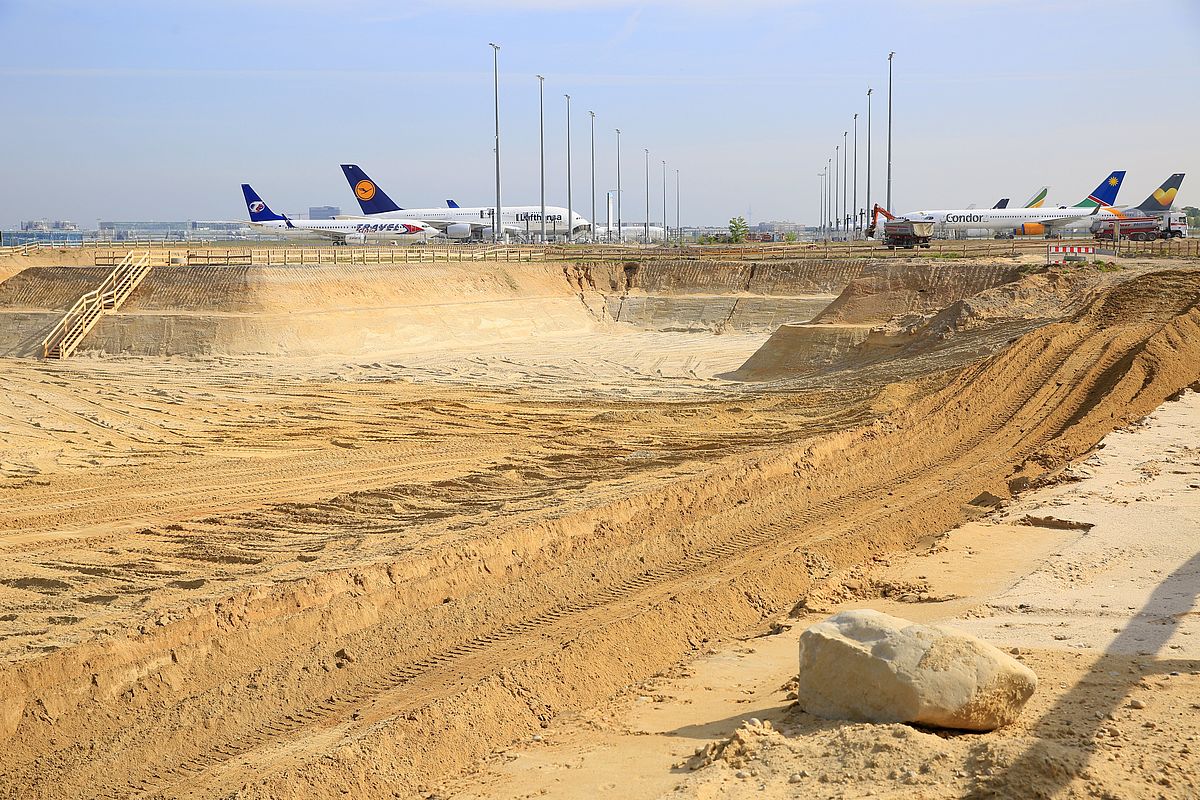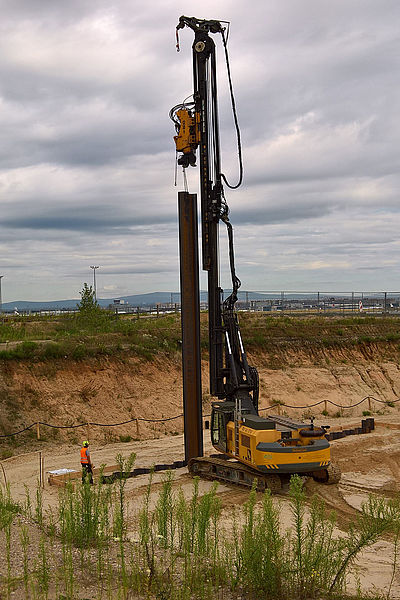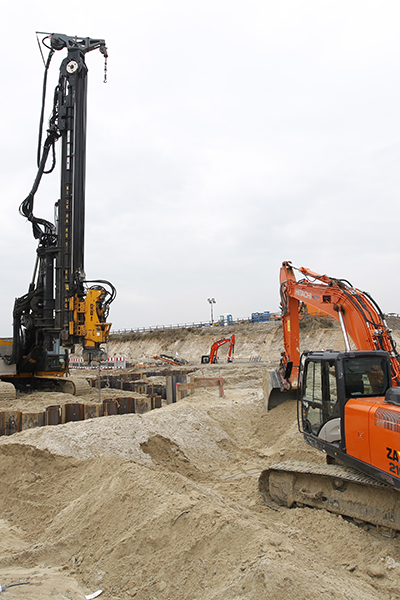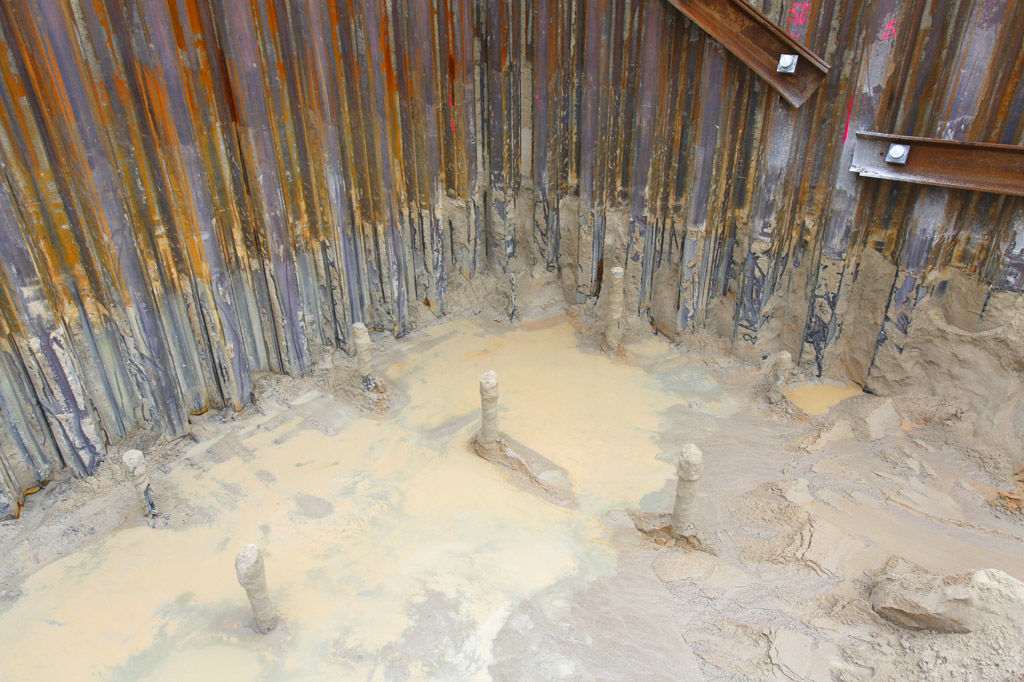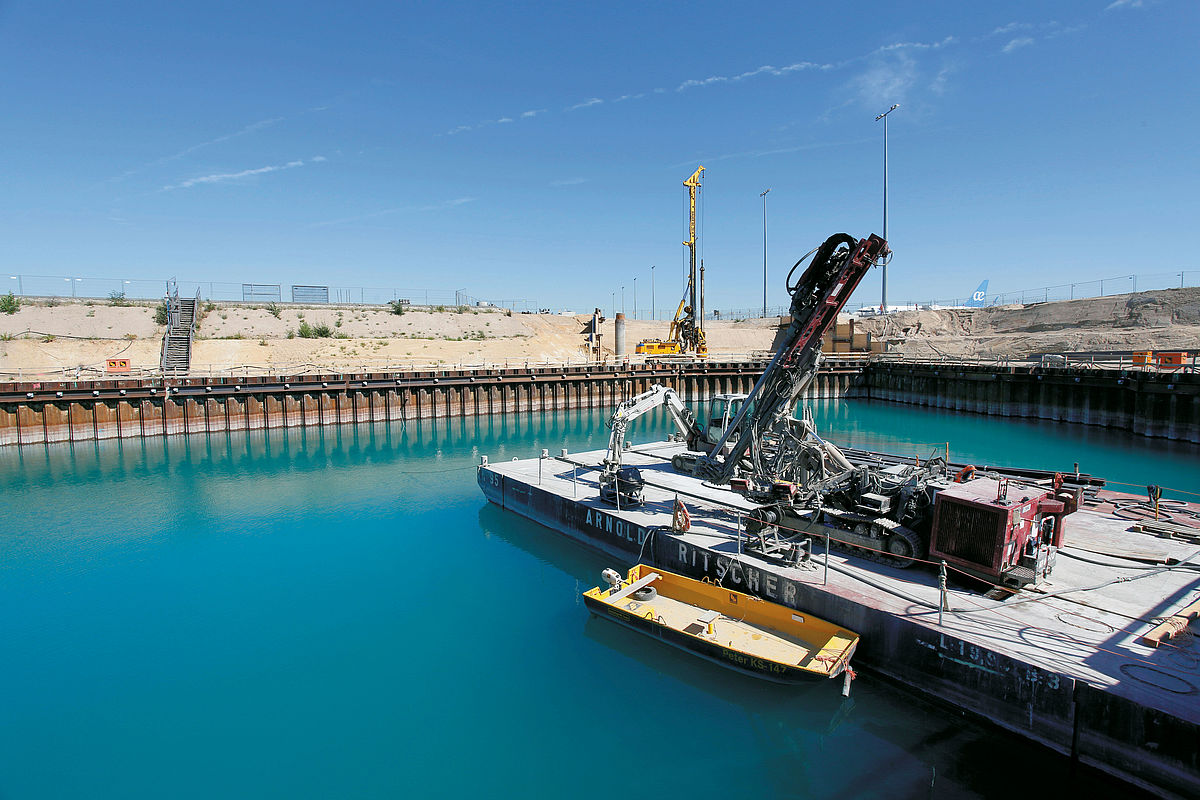
From Excavators to Divers:
Foundation Engineering
Dry Excavation
Fascinating Worlds and Unexpected Depths
Sand and earth as far as the eye can see ... the scene would be reminiscent of a gargantuan sandbox if there weren’t airplanes constantly taking off and landing at the rate of about one a minute. In actual fact, it’s the construction pit for Terminal 3, Europe’s largest privately funded infrastructure project. It covers an area of 65,900 square meters and extends down to a depth of 5.5 meters, or just above the water table. Before the new terminal building can rise up, first it’s necessary to dig down. But it took years of planning work before the excavators could begin removing soil.
Lengthy Planning
The land on which Terminal 3 is now being built not only has enormous implications for the future of aviation in the Rhine-Main Region, but also looks back on an eventful history.
 At the end of World War II, the U.S. military occupied the Frankfurt/Rhein-Main Airfield and renamed it the Rhein-Main Air Base. Just a few years later, it was used to supply the residents of Berlin by airlift when that city was blockaded by the Soviet Union.
The U.S. Air Force operated the facility between 1945 and 2005, turning it into the world’s largest military airport outside the United States. It was home to up to 7000 military personnel and their families. Since the site was returned to Germany in 2005, the former American “Gate to Europe” has become part of that country’s “Gateway to the World”.
At the end of World War II, the U.S. military occupied the Frankfurt/Rhein-Main Airfield and renamed it the Rhein-Main Air Base. Just a few years later, it was used to supply the residents of Berlin by airlift when that city was blockaded by the Soviet Union.
The U.S. Air Force operated the facility between 1945 and 2005, turning it into the world’s largest military airport outside the United States. It was home to up to 7000 military personnel and their families. Since the site was returned to Germany in 2005, the former American “Gate to Europe” has become part of that country’s “Gateway to the World”.
It wasn’t long after the completion of Terminal 2 that it became clear that yet another new terminal would eventually be required. Fraport initiated talks with the city of Frankfurt on further expansion of the airport in the 1990s. After the official building permit was issued in 2012, work to draw up detailed plans got started.
Starting Gun for the Foundation Work
“After more than 15 years of intensive planning, approval procedures and checks, today we are pleased to start the construction of Terminal 3 at Frankfurt Airport. This terminal will not only ensure the future viability of Germany’s largest aviation hub and create new jobs and prospects for our
 The construction of Terminal 3 kicked off with an official groundbreaking ceremony. (October 2015)
employees. It will also contribute to ensuring the economic prosperity of the entire region and beyond.” (Dr. Stefan Schulte, Executive Board Chairman of Fraport AG)
The construction of Terminal 3 kicked off with an official groundbreaking ceremony. (October 2015)
employees. It will also contribute to ensuring the economic prosperity of the entire region and beyond.” (Dr. Stefan Schulte, Executive Board Chairman of Fraport AG)
Before the excavators started digging, on October 5, 2015 a total of 400 Fraport AG employees gathered at the site of the future terminal along with CEO Schulte, Governor Volker Bouffier of Hesse and many other invited politicians and business leaders for an event with the motto “We’re on board! Groundbreaking for Terminal 3”. Wearing neon-yellow vests and blue helmets, they gave the official starting gun for the first phase of construction, namely dry excavation.
The Excavators Start Moving
 The dry excavation phase ended when a depth of 5.5 meters was reached. (2016)
As soon as the groundbreaking ceremony was finished, everyone got out of the way so the heavy machinery could start rolling. It would probably take a single person decades to dig such an enormous pit. Instead, five excavators, each with a shovel volume of up to two cubic meters, plus three bulldozers and countless dump trucks accomplished it in just half a year. At the peak of the work, they extracted and removed earth at the rate of around 5,500 cubic meters, or about 300 truckloads, each day.
The dry excavation phase ended when a depth of 5.5 meters was reached. (2016)
As soon as the groundbreaking ceremony was finished, everyone got out of the way so the heavy machinery could start rolling. It would probably take a single person decades to dig such an enormous pit. Instead, five excavators, each with a shovel volume of up to two cubic meters, plus three bulldozers and countless dump trucks accomplished it in just half a year. At the peak of the work, they extracted and removed earth at the rate of around 5,500 cubic meters, or about 300 truckloads, each day.
This interactive informational graphic gives an overview of the site and shows what was moved during the dry excavation phase. Click on the numbers to learn more.
The dry excavation work was the first step in preparing to lay the terminal’s foundation. In the still-ongoing second phase, sections of the pit have been deepened to between eight and eleven meters below the water table, bringing a lot of water into play in addition to earth.

Special Foundation Work
Divers at the Construction Site
We normally associate divers more with thrilling deep sea expeditions and coral reefs than with Germany’s largest airport. But the fact is that it takes more than excavators, cranes and construction workers to build Terminal 3. The next phase is that of special foundation work, during which trained divers round out the team and work underwater in the flooded construction pit. So that travelers will later be able to do everything from check-in to boarding on a single level without having to navigate stairs, it is necessary to accommodate sophisticated equipment and systems on two subterranean levels, which is why the pit has to be so deep.
This interactive informational graphic gives an overview of the site and shows what happens during the Special Foundation Work. Click on the numbers to learn more.
Shaken Not Stirred!
At the end of the dry excavation phase, the Terminal 3 construction site resembled a gigantic sandbox. But that changed completely in mid-2017, when special excavators began digging down even further in defined areas. Soon they were working in deep water, since the water table was reached after another one or two meters. To seal and stabilize these sections, they were surrounded by retaining walls consisting of 14-meter-long steel plates called sheet piles. The first step is to loosen the sand down to a depth of 14 meters using a gargantuan rotary drilling rig over 15 meters tall. Then enormous construction machines known as telescopic leader masts come into play and gradually install 7,100 tonnes of steel retaining walls.
Sheet after sheet was inserted to contain the terminal’s underground areas. They slid into the sandy soil, which is typical of the area south of the Main River around Frankfurt Airport, like a hot knife through butter. While this was going on, a construction worker repeatedly used a bubble level to make sure that the steel sheets were absolutely vertical.
 Special foundation work not only consists of excavating but also of "shaking" to seal and stabilize the sections. (2017)
Special foundation work not only consists of excavating but also of "shaking" to seal and stabilize the sections. (2017)
The walls’ combined surface area of 46,000 square meters is roughly equivalent to six large soccer fields like the one at the Commerzbank Arena in Frankfurt. The walls define individual plots for creating the underground levels of the new Terminal 3. As soon as each plot is completely surrounded by retaining walls, excavators start removing earth from it. First they dig down one or two meters – just enough so that an anchor drill can fasten the walls to the soil behind them. It takes a total of 550 anchors to stabilize all of the individual plots and the overall construction pit so that excavation can continue.
Wetter and Wetter
 Challenging working conditions: Carsten Thörmer, Managing Director Aqua-Nautik GmbH, explains the tasks of the state-certified industrial divers on the construction site of Terminal 3. (June 2019)
Challenging working conditions: Carsten Thörmer, Managing Director Aqua-Nautik GmbH, explains the tasks of the state-certified industrial divers on the construction site of Terminal 3. (June 2019)
After securely anchoring the sheet piles at each stage, the excavators continued to extract even more earth down to a final depth between eight and eleven meters. By this time the pit was far below the water table and therefore filled with deep water. But before it could be pumped out, the bottom of the pit had to be sealed by pouring concrete underwater. Now divers on the scene arrive to support the underwater concreting work. To do their jobs, certain handicaps must be overcome: oxygen tanks are a must to compensate for the lack of air under water, and visibility is much poorer than in a clear mountain lake or the crystalline waters of a Caribbean island. Amazing Underwater Astronauts
Once a pit is excavated to below the groundwater level, causing it to flood, trained and officially certified divers go into action as essential members of the team. They wear gear that can weigh up to 35 kilos and resembles a spacesuit. It includes a special helmet weighing 12 kilos that supplies them with oxygen and lets them communicate with a supervisor up above. Neoprene wetsuits with a special thermal lining keep them warm, which is necessary since the water is often quite cold.
Unlike in an ocean or lake, the construction work stirs up a lot of earth and sand. The resulting poor visibility makes life difficult for the divers working in the flooded pit.
A special procedure is used to remove as much sand and soil as possible from the water. This permits the specially trained divers to see objects up to a meter away while submerged. Despite this, it’s essential for them to use all of their senses. Good hearing and an acute sense of touch are vital for performing their demanding task
Terminal 3 requires a stable foundation. Around 3500 uplift anchors are therefore driven into the bottom of the excavated pit before covering it with 39,000 square meters of concrete that is poured underwater. The concrete binds to the anchors while setting, which prevents it from drifting out of place. The divers check the anchors and make sure that the substrate is properly prepared. So that the concrete flows into place evenly under water, it’s necessary to remove any soil adhering to the retaining walls or uplift anchors. After the divers have inspected the entire pit, concrete is pumped down to the bottom.
Because it’s impossible to see whether the poured concrete forms a level surface, the divers use a pipe with a bell jar-shaped termination at the bottom. This makes it easy for them to spread the concrete evenly, working gradually across the pit’s bottom until a smooth layer of concrete is obtained.
From Sand to Water to Concrete
Dry under water Concrete consists of cement and aggregate (sand, gravel or small stones). This combination is what allows concrete to completely cure under water (unlike clay, for example). The cement dissolves in the water and reacts chemically with it (a process called hydration) to form a hard matrix that binds the aggregate to form a durable stone-like material. In other words, concrete doesn’t actually “dry” when it sets. Excessive drying actually weakens the reaction, so concrete that hardens underwater can be stronger than when it cures in air. The water is therefore not removed from the pits until the concrete at the bottom has thoroughly set.It takes between 30 and 50 days for concrete to cure completely under water. Once it does, the last stage of the special underground engineering work is to pump the water out of the pit sections and purify it in a series of steps. It is then returned to the ground via specially installed percolation basins and allowed to flow down into deep soil layers. Everything is designed to accomplish this in a highly eco-friendly, groundwater-conserving manner, and both the groundwater itself and the systems used are continually monitored.
“Frequent checks are an important part of groundwater-conserving construction,” says Kristin Lütke. She coordinates the measures for monitoring the quality of the groundwater and purifying it at the construction site. Over the course of several years, groundwater samples are taken at multiple sites to check their quality and quantity. An independent engineering firm also constantly watches over the activated charcoal filter system to ensure that only purified groundwater percolates into the soil.
In October 2019, the industrial divers will be placing the underwater concrete in the remaining, water-filled pit for the last time. As soon as it is dry and the drainage process has been completed, the Terminal 3 construction site in the south of the airport will have evolved from a giant sandbox and then a water-filled basin into a number of concrete-lined pits. And when the next construction phase gets underway, the future terminal will begin growing skyward as the shells of the main terminal building and Piers H and J take shape.
Stay up-to-date with building construction here!
Home


